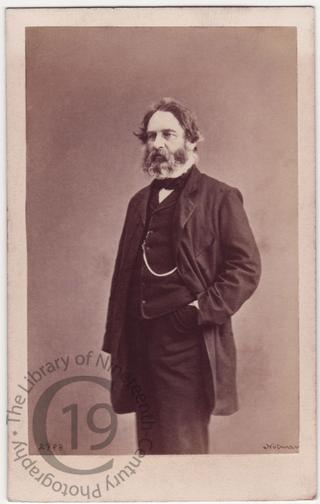
Henry Longfellow
A carte-de-visite portrait of the American poet Henry Wadsworth Longfellow (1807-1882).
Born in 1807 in Portland, Maine, Longfellow became one of the most popular writers of his time, his work ranging from sentimental pieces such as The Village Blacksmith to translations of Dante.
He was educated at private schools and at Bowdoin College. After graduating in 1825 he travelled to Europe for three years. On his return he became a professor of languages at Bowdoin and married his first wife, Mary Potter. During this period he published a series of travel sketches entitled Outre-mer: A Pilgrimage beyond the Sea (1833-35). On a second trip to Europe his wife died. When he returned he took up a teaching position at Harvard.
His first volume of poems, Voices of the Night, and a prose romance, Hyperion, were both published in 1839. A second collection of verse appeared in 1842. In the following year he married Frances Appleton and settled in Cambridge, Massachusetts, where he remained for the rest of his life. His house there is now a museum.
Longfellow's later work reflects his reading of European epics and his interest in establishing an American mythology. His most famous work, The Song of Hiawatha (1855), a long narrative poem whose hypnotic melody has often been parodied, is very much a part of this joyous vision of America, filled with a spirit of optimism and the goodness of life.
Photographed in 1862 by William Notman of Montreal.
Code: 124315




